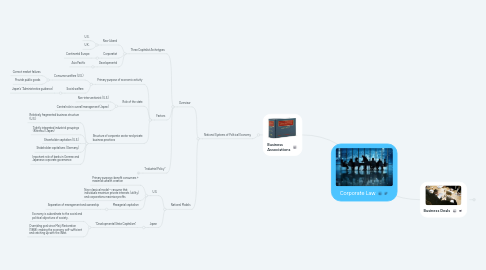
1. Business Associations
1.1. National Systems of Political Economy
1.1.1. Overview
1.1.1.1. Three Capitalist Archetypes:
1.1.1.1.1. Neo-Liberal
1.1.1.1.2. Corporatist
1.1.1.1.3. Developmental
1.1.1.2. Factors
1.1.1.2.1. Primary purpose of economic activity
1.1.1.2.2. Role of the state
1.1.1.2.3. Structure of corporate sector and private business practices
1.1.1.3. "Industrial Policy"
1.1.1.3.1. Deliberate efforts by governments to determine the structure of the economy through various devices like: trade protection; financial subsidies; government procurement.
1.1.1.3.2. "Picking winners"
1.1.2. National Models
1.1.2.1. U.S.
1.1.2.1.1. Primary purpose=benefit consumers + maximize wealth creation
1.1.2.1.2. Neo-classical model-->assume that individuals maximize private interests (utility) and corporations maximize profits
1.1.2.1.3. Managerial capitalism
1.1.2.2. Japan
1.1.2.2.1. "Developmental State Capitalism"
2. Business Deals
2.1. Overview
2.1.1. General Guidance for Deal Lawyers
2.1.2. Introduction to Drafting and Negotiating Corporate Agreements
2.1.2.1. General Themes:
2.1.2.1.1. Summary:
2.1.2.1.2. Controlling the Drafting
2.1.2.1.3. Drafting in Context
2.1.2.1.4. Structuring First to Minimize Redrafting
2.1.2.1.5. Understanding and Addressing the Client’s Special Needs
2.1.2.1.6. Drafting for the Appropriate Time Horizon
2.1.2.1.7. Relying on Forms
2.1.2.1.8. Drafting Agreements that Work Well Together
2.1.2.1.9. Listening Before Negotiating
2.1.2.1.10. Adopting an Effective Negotiating Style
2.1.2.1.11. Prioritizing Issues and Understanding Interrelationships
2.1.2.1.12. Studying Your Counterparty
2.1.2.1.13. Deciding Whether to Tackle Small or Big Issues First
2.1.2.1.14. Communicating With Your Client and Formulating an Effective Strategy
2.1.2.2. Common Types:
2.1.2.2.1. Confidentiality agreements, standstill agreements, term sheets and letters of intent, employment agreements, shareholder agreements, credit agreements and indentures, merger and acquisition agreements, service agreements, licensing agreements and distribution agreements
2.2. Two Broad Categories of Business Deals:
2.2.1. 1. M&A Transactions
2.2.1.1. M&A Primer
2.2.1.1.1. Terminology:
2.2.1.1.2. General Reasons for M&A Activity:
2.2.1.1.3. Common M&A Structures:
2.2.1.1.4. Factors Determining Structure:
2.2.1.1.5. Principal Players:
2.2.1.1.6. Legal Framework:
2.2.1.1.7. Primary DIfferences in Acquiring "Public" vs. "Private" Companies:
2.2.1.1.8. Securities Law Compliance and Reporting Obligations:
2.2.1.2. Universal Issues and Preliminary Documents
2.2.1.2.1. Overview
2.2.1.2.2. Confidentiality Agreements/NDAs
2.2.1.2.3. Standstills
2.2.1.2.4. Letters of Intent (LOI)
2.2.1.2.5. Exclusivity Agreements
2.2.1.3. Due Diligence
2.2.1.4. Key Issues in Drafting and Negotiating Acquisition Agreements
2.2.2. 2. Ordinary Course Business Dealings
2.2.2.1. General Types
2.2.2.1.1. Service agreements
2.2.2.1.2. Consulting engagements
2.2.2.1.3. Customer and supplier agreements
2.2.2.1.4. Strategic alliances
2.2.2.2. Industry/Sector
2.2.2.2.1. Technology
2.2.2.2.2. Oil and Gas
